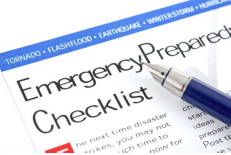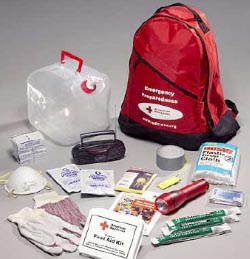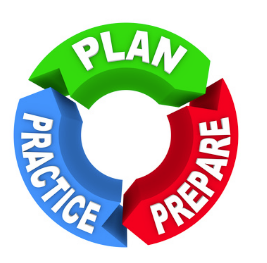Emergency Preparedness
Preparedness at Home
 “Be Prepared” is not just a Boy Scout motto, it is a way of life. Emergencies occur all the time. Whether accidents, basement flooding, severe thunderstorms, tornadoes or medical problems, all emergencies have some common elements. They are relatively unexpected; you may quickly be overwhelmed; and lives, health, and the environment are often endangered.
“Be Prepared” is not just a Boy Scout motto, it is a way of life. Emergencies occur all the time. Whether accidents, basement flooding, severe thunderstorms, tornadoes or medical problems, all emergencies have some common elements. They are relatively unexpected; you may quickly be overwhelmed; and lives, health, and the environment are often endangered.
How prepared you are will often determine whether the emergency produces disastrous consequences for you and your family. Knowing what to do and being prepared can lessen the impact on you and your family.
Every family should take the following steps to BE PREPARED.
Get a Kit of Emergency Supplies
What would you need to survive on your own for at least three days, maybe longer? Fresh water, food and clean air are essential. What if the power is out? Flashlights and radios, along with extra batteries would be helpful. And don’t forget about medical supplies, sanitation needs and any special considerations.
A basic supply kit shall include:
- Water, one gallon of water per person per day for at least three days, for drinking and sanitation
- Food, at least a three-day supply of non-perishable food
- Battery-powered or hand crank radio and a NOAA Weather Radio with tone alert and extra batteries for both
- Flashlight and extra batteries
- First aid kit
- Whistle to signal for help
- Dust mask to help filter contaminated air and plastic sheeting and duct tape to shelter-in-place
- Moist towelettes, garbage bags and plastic ties for personal sanitation
- Wrench or pliers to turn off utilities
- Manual can opener for food
- Local maps
- Cell phone with chargers, inverter or solar charger
 Once you have gathered the supplies for a basic emergency kit, you may want to consider adding the following items:
Once you have gathered the supplies for a basic emergency kit, you may want to consider adding the following items:
- Prescription medications and glasses
- Infant formula and diapers
- Pet food and extra water for your pet
- Cash or traveler's checks and change
- Important family documents such as copies of insurance policies, identification and bank account records in a waterproof, portable container
- Sleeping bag or warm blanket for each person
- Complete change of clothing including a long-sleeved shirt, long pants and sturdy shoes
- Household chlorine bleach
- Fire extinguisher
- Matches in a waterproof container
- Feminine supplies and personal hygiene items
- Mess kits, paper cups, plates, paper towels and plastic utensils
- Paper and pencil
- Books, games, puzzles or other activities for children
Make a Plan
Every family should have a Family Communication Plan, a Shelter-In-Place Plan and an Evacuation Plan. In addition, become familiar with emergency plans at school and work. Practice those plans by holding both scheduled and unscheduled fire and tornado drills at both home and work. www.ready.gov provides great templates for children and adults.
 Family Communication Plan
Family Communication Plan
Your family may not be together when disaster strikes, so plan how you will contact one another and review what you will do in different situations. Consider a plan where each family member calls, or emails, the same friend or relative in the event of an emergency.
Evacuation Plan
Plan in advance how you will assemble your family and anticipate where you will go. Choose several destinations in different directions. If you do not have a car, plan how you will leave if you have to. Take your emergency supply kit, unless you have a reason to believe it is contaminated. Take your 3 P’s with you: pills, pets and purses.
Shelter-in-Place
There are circumstances when staying put and creating a barrier between yourself and potentially contaminated air outside can be a matter of survival. If you see large amounts of debris in the air, or if local authorities say the air is contaminated, you may want to shelter-in-place and seal the room. Consider precutting plastic sheeting to seal windows, doors and air vents. Each piece should be inches larger than the space to cover so that it can be duct taped flat against the wall.
Be Informed
Take the time to learn more about the natural and man-made threats that can impact us in SE Wisconsin. Contact Racine County Emergency Management for more information.
Get Involved
There are multiple ways that you can get involved. Start a Neighborhood Watch on your block, take a first aid class or become involved with Wisconsin Emergency Assistance Volunteer Registry (WEAVR).
